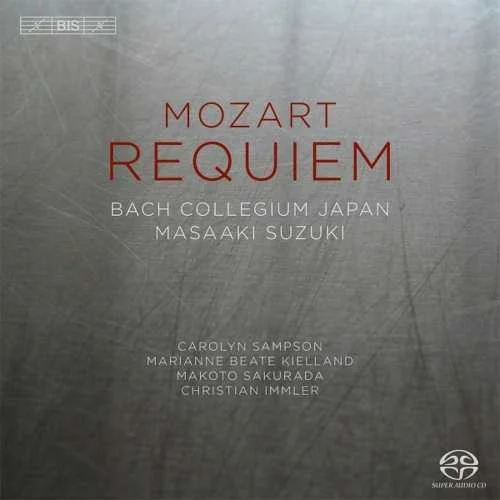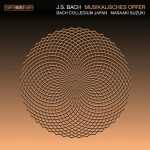
Composer: Wolfgang Amadeus Mozart
Performer: Carolyn Sampson, Marianne Beate Kielland, Makoto Sakurada, Christian Immler
Orchestra: Bach Collegium Japan
Conductor: Masaaki Suzuki
Audio CD
Number of Discs: 1
Format: FLAC (tracks)
Label: Bis
Release: 2014
Size: 1.29 GB
Recovery: +3%
Scan: yes
Requiem, K. 626 (1791)
01. I. Introitus: Requiem
02. II. Kyrie
III. Sequentia
03. 1. Dies irae
04. 2. Tuba mirum
05. 3. Rex tremendae
06. 4. Recordare
07. 5. Confutatis
08. 6. Lacrimosa
09. 7. Amen
IV. Offertorium
10. 1. Domine Jesu
11. 2. Hostias
12. V. Sanctus
13. VI. Benedictus
14. VII. Agnus Dei
15. VIII. Communio: Lux aeterna
Vesperae solennes de confessore, K. 339 (1780)
16. I. Dixit Dominus (Psalm 109)
17. II. Confitebor (Psalm 110)
18. III. Beatus vir (Psalm 111)
19. IV. Laudate pueri (Psalm 112)
20. V. Laudate Dominum (Psalm 116)
21. VI. Magnificat
Appendix:
22 Tuba mirum from Requiem, alternative version
(see notes by Masato Suzuki)
Recording: December 2013 at the Kobe Shoin Women’s University Chapel, Japan
“Taking its place as one of the finest period-instruments accounts, Suzuki’s is a vital, engaging and atmospheric reading.” International Record Review
Since its creation in 1791, Mozart’s Requiem has become one of the truly iconic works in the history of music. A prime reason for this is of course its musical qualities: as early as 1814 E.T.A. Hoffmann described the Requiem as ‘the most sublime achievement that the modern period has contributed to the church’. But even before that legends had begun to form around the work; that it was written to fulfil an anonymous commission – received through ‘an unknown, grey stranger’ – is the stuff of mystery novels, while the fact that Mozart fell ill and died while composing it has been exploited to great melodramatic effect. Among the numerous myths, one thing that we know for certain is that its first performance took place only a few days after Mozart’s death, at a memorial service for the composer. The performers used the composer’s incomplete autograph, but very soon attempts to complete the work were set in motion by Mozart’s widow. She first engaged Joseph Eybler and later Franz Xaver Süßmayr for the task, and in 1800 the Requiem appeared in print, in Süßmayr’s completion. This is still by far the most widely performed version, but it has also been severely criticized over the years, and many have tried to improve on it, or make their own versions based on the autograph. For this recording of the work, Masaaki Suzuki and the Bach Collegium Japan commissioned a new performing edition. Masato Suzuki, himself a member of the BCJ and the son of Masaaki, has based his completion on Eybler’s and Süßmayr’s work, explaining his procedure in the liner notes to the disc. The recording was made at the Shoin Chapel in Kobe, where the team has previously recorded their complete cycle of Bach’s church cantatas. A stellar cast of soloists is headed by soprano Carolyn Sampson, who also shines in the famous soprano aria Laudate Dominum – one of the highlights of Vesperae solennes de confessore which conclude the disc.



